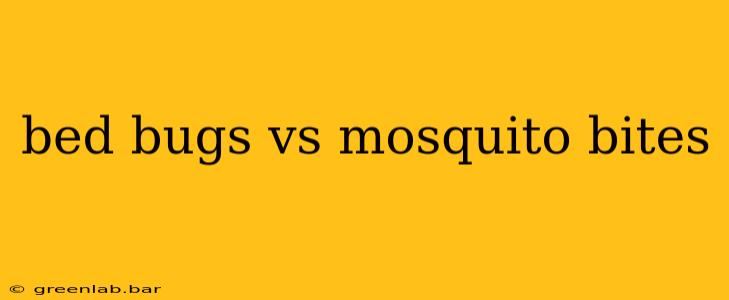Identifying the culprit behind those itchy welts can be tricky. Are they bed bugs or mosquitoes? While both insects feed on human blood, leaving behind itchy bites, there are key differences that can help you distinguish between the two. This comprehensive guide will delve into the characteristics of each bite, offering clear visual and symptomatic comparisons to help you pinpoint the pest problem in your home.
Visual Differences: Bed Bug Bites vs. Mosquito Bites
The most apparent difference lies in the pattern and appearance of the bites themselves.
Bed Bug Bites:
- Appearance: Bed bug bites often appear as small, red, itchy welts, similar to mosquito bites in initial appearance. However, they are often clustered together in a line or zig-zag pattern, often referred to as a "breakfast, lunch, and dinner" pattern, reflecting the insect's feeding habits.
- Shape: Individual bites may be round or slightly swollen.
- Location: While they can occur anywhere on the body, bed bugs tend to bite exposed skin while you are sleeping. Common areas include the arms, neck, face, and hands. They often avoid hairy areas.
- Reaction: The reaction varies depending on individual sensitivity. Some experience minimal reaction while others suffer significant itching, swelling, and even secondary infections from scratching.
Mosquito Bites:
- Appearance: Mosquito bites typically appear as a single, raised, red bump. They are often less clustered than bed bug bites.
- Shape: Usually round and relatively uniform in size.
- Location: Mosquitoes can bite anywhere on exposed skin, even through clothing.
- Reaction: Similar to bed bug bites, reaction varies depending on sensitivity. Some experience only mild itching while others experience significant swelling and intense itching.
Beyond the Bite: Other Key Distinguishing Factors
While visual inspection is helpful, other factors can help determine the type of insect causing the bites:
Bite Timing:
- Bed Bugs: Bites often appear in the morning after sleeping, as they are nocturnal feeders.
- Mosquitoes: Bites can occur anytime, particularly during dawn and dusk, when mosquitoes are most active.
Insect Presence:
- Bed Bugs: Check your mattress seams, box springs, bed frames, and even electrical outlets for signs of bed bugs—small, brown insects (adults are about the size of an apple seed), their fecal spots (tiny dark dots), or shed skins.
- Mosquitoes: Look for mosquitoes themselves—typically flying insects with long legs and proboscis—in areas with standing water or lush vegetation near your home.
When to Seek Medical Attention
While most bed bug and mosquito bites are harmless, you should seek medical attention if:
- Severe allergic reaction: Difficulty breathing, swelling of the face or throat, or widespread hives.
- Secondary infection: Signs of infection, such as increased pain, swelling, pus, or red streaks radiating from the bite.
- Persistent symptoms: If symptoms don't improve after several days or worsen despite treatment.
Conclusion: Effective Pest Control
Identifying the source of your bites is the first step in implementing effective pest control. For bed bugs, this usually involves professional extermination services due to their ability to quickly infest and re-infest a home. For mosquitoes, preventative measures, such as eliminating standing water and using insect repellents, are crucial. Remember, proper identification is key to successful pest management.

